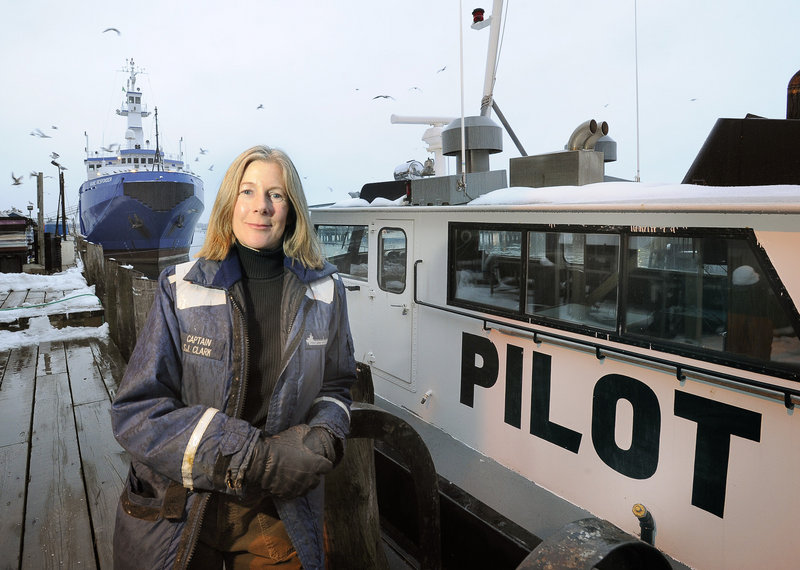An Italian captain’s decision to abandon his cruise ship after it crashed on rocks off the coast of Italy was an abdication of the accepted training and responsibility of a ship’s master, say captains who work along Maine’s coast.
The Maine captains were hesitant to critique Capt. Francesco Schettino’s decisions leading up to the grounding of the Costa Concordia until reliable information becomes available, but they agreed that a captain’s responsibility is to stay with the vessel as long as possible.
“I was blown away,” Capt. Susan Clark said of Schettino’s decision to leave the ship while passengers were still on board.
Clark, who commanded oil tankers before joining Portland Pilots Inc., said, “I think anyone that sails as a master believes that they’re responsible for their crew and their cargo – passengers in this case.”
Capt. Earl Walker, who piloted vessels into Portland Harbor for 31 years and now guides destroyers from Bath Iron Works out of the Kennebec River for sea trials, was equally baffled.
“It’s still a little early to say what did happen. All we know is, the captain left the ship, and that’s a no-no,” Walker said. “If it happened to me, I would prefer to go down with the ship. If I lost a ship of that caliber, I wouldn’t want to be around.”
The Costa Concordia crashed into a reef off the island of Giglio on Friday night. Press reports say Schettino had gone off course to sail close to the island as a favor to his head waiter, who is from the island. Costa Crociere, a subsidiary of Carnival, which owns the cruise ship, said he made an unauthorized deviation from his course.
After the collision, the ship went north for a period, then turned back toward the island and ran aground, eventually toppling to its starboard side.
“It appears the one thing the captain did right was to turn the ship around and beach her,” so the ship did not sink in deep water a mile or two offshore, Walker said, “but after that everything else was really not in the best interest of the ship and the passengers and the crew.”
The catastrophe has been the subject of intense discussion in Maine’s maritime industry.
“Most of the conversation has been one of sort of confusion and disbelief and desire to find out exactly what happened,” said Capt. David Gelinas of the Penobscot Bay and River Pilots Association, which guides 90 cruise ships a year into Bar Harbor, as well as other ships. “We’re all kind of scratching our heads.”
There is agreement about the captain’s decision to leave while passengers were still being evacuated from the ship.
“Most of the professionals I work with or have worked with would stay (on board) and certainly be the last, or one of the last, people off,” Gelinas said.
Once the passengers were safe, the crew and officers would leave, then, finally, the captain.
Mariners are optimistic that the bridge voice recorder and engine data recorders will answer questions about the crash.
“It’s a little unbelievable to people in the industry that someone would deviate so much and come so close (to shore),” Gelinas said. “It’s confounding.”
There’s little chance that a similar disaster could happen along the coast of Maine, Gelinas said. Any vessel that sits 9 feet or deeper in the water must have a Maine pilot, independent of any shipping company, guiding it when it enters Maine waters.
It’s a pilot’s duty to know the ocean floor, know a ship’s proper course and stick with it, said Capt. Mark Klopp, president of Portland Pilots Inc.
“The ships that come into Portland Harbor need to stay within the confines of the channel. We do not deviate from that,” Klopp said.
Although Schettino may not have been authorized by his company to deviate significantly from his course, a captain’s power on board a ship is nearly absolute.
“Companies usually issue guidelines of where they want vessels to go, but in the end it’s up to the captain to plot the final course,” said Capt. Les Eadie, master of the Maine Maritime Academy’s training ship, the State of Maine.
Some deviations are expected, especially to avoid bad weather. “Going too close to shore to wave at people or blow a whistle is probably not something the company had in mind for deviations,” Eadie said.
Eadie said video he has seen shows crew members standing at lifeboat hatches with radios, as if they were waiting for the order to launch.
It’s not clear why the order was delayed. Lifeboats can’t be launched if a ship is moving forward, because they will drift aft and tangle and crash into other lifeboats, Eadie said.
Once the facts of the crash are known, the information will become material for Maine Maritime’s casualty analysis course, he said.
Staff Writer David Hench can be contacted at 791-6327 or at:
dhench@pressherald.com
Send questions/comments to the editors.



Success. Please wait for the page to reload. If the page does not reload within 5 seconds, please refresh the page.
Enter your email and password to access comments.
Hi, to comment on stories you must . This profile is in addition to your subscription and website login.
Already have a commenting profile? .
Invalid username/password.
Please check your email to confirm and complete your registration.
Only subscribers are eligible to post comments. Please subscribe or login first for digital access. Here’s why.
Use the form below to reset your password. When you've submitted your account email, we will send an email with a reset code.